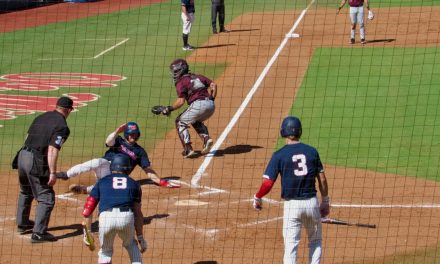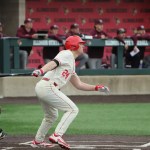OXFORD, Miss. — Ole Miss had the weekend off this past Saturday, and that gave me a chance to look at the national college football scene with a closer vision.
Georgia, Michigan, Ohio State and Florida State are all good. Arizona is the best 4-3 team in the country. James Madison is still the best Group of Five team and Jayden Daniels should be in the Heisman conversation.
A friend kept messaging me during the day about the playoffs. Not the one this season, but the expanded 12-team one that is on the horizon. He kept asking me which three teams from the same conference did I think would get bids next year.
I have no clue. But it did put a thought in my head.
Several conferences are doing away with divisions next season. The top two teams will play for the league title before embarking on a playoff run. The top two teams will play that game. So is it better to be a third place team in your conference that is still ranked in the Top 10?
Think about it. Say you coach a team in a conference where the first-place team is 12-0 and you and another team finished 11-1. But that other 11-1 team dealt you your only loss.
You should throw a party in that scenario.
Instead of an extra game with an undefeated team where you could risk injury or play so badly it hurts your team’s confidence, you get to sit home and heal the sore shoulders, the bruised ribs, pulled hamstrings and twisted ankles. You are gifted with a couple of extra weeks to get healthy and develop a playoff plan. During that time, the two teams ahead of you are bashing their bodies together and possibly weakening their teams.
College football has officially become weird when it can be more advantageous to finish third in your conference than win it.
Ask any coach and he will say he would rather have a national championship than a league title.
A SMART CLASS
Face it, the ins-and-outs of NIL in college athletics are difficult to understand at best. But at Troy University, through its Idea Bank program, Name, Image and Likeness could be simplified a bit.
The university is offering a class to all Trojan student-athletes to learn more about the initiative. The course is designed to not only teach the student-athletes about NIL, but also how it can be utilized at a smaller school.
The director of the program, Professor Lynne George, wants to illustrate how NIL can work in a town like Troy. Troy is the second-smallest town that is home to a Football Bowl Subdivision school, ranking just above West Point, N.Y. Coincidentally, Troy visited Army Saturday and left with a 19-0 win.
George hopes the program shows the student-athletes NIL can work at a smaller school. Especially one in Troy which is home to so many small, independent businesses.
MIDWEEK GAMES
In years past, I had not been overly fond of midweek college football games. But with the strike in Hollywood, at least there is now unique programming instead of reruns and bad reality shows.
The midweek games are a good way for Group of Five schools to showcase their teams. But some may be going overboard.
Western Kentucky will go 56 days without a home game that will be played on a Saturday. That means no recruits will be visiting the Bowling Green, Ken., campus, especially on Thursdays when the high school players are preparing for a Friday night game.
What really hurts is the attendance to the games. Bowling Green is a fine town, I have covered games there and it is great. But if Hilltopper fans live a couple of hours away from the campus, they must either watch the game on television or take a couple of days off work to attend.
I understand the coaches love telling recruits the Hilltoppers are on television with little other programming to compete with the game. But each time there is a kickoff and the television cameras follow the ball, guess what is in the background? An empty stadium.
It is great to be on television so much, but it cannot be a selling tool to recruits when they see very few fans at the game.
MONEY, MONEY, MONEY, MONEY
What do Florida State, Oregon State, South Alabama and Western Kentucky have in common this season? They are the only teams in the FBS to be absolutely perfect in the red zone this year.
OSU has been in the red zone 22 times this year. The Beavers have scored 20 touchdowns and kicked a pair of field goals.
Florida State and South Alabama have each visited the red zone 20 times. The Seminoles have scored 16 touchdowns and kicked four field goals, while the Jaguars have put the ball into the end zone 16 times and kicked four field goals themselves.
WKU has been in the red zone 19 times, crossed the goal line 15 times and kicked four field goals.
How important is that statistic? Those four teams are a combined 19-6 this season.
MAYBE WATCH OUT FOR THAT SLANT ROUTE
Friday, Colorado blew a 29-0 halftime lead and lost to Stanford 46-43 in double overtime.
The Cardinal threw for 399 yards in the game with wide receiver Elic Ayomanor setting a school record with 294 yards receiving.
It seemed like he ran a slant route for the majority of his 13 catches and the Colorado secondary never covered it. In the third quarter, Ayomanor took a pass from Ashton Daniels on a short slant route and took it 97 yards for a touchdown to give Stanford some momentum.
Ayomanor also caught touchdowns of 60 and 30 yards, but the damage was mostly done on the short slant patterns. Each time he ran it, it seemed like he would pick up 11 yards and keep a drive moving.
Deion Sanders was one of the best cover corners in college or professional football. One would think he would be able to communicate to his secondary or at least his defensive coordinator to look out for the slant.
By the way, conferences who are proud to have team on the Atlantic and Pacific coasts for television, there’s a tad bit of a problem. The Colorado-Stanford game finished after 2:00 a.m. Eastern time. Boulder is on Mountain time. Imagine how late it would have been in Palo Alto.
Like this:
Like Loading...
Related
Steve Barnes
Steve Barnes joins The Rebel Walk staff as a senior writer and brings a trifecta of journalistic experience. As a writer, he has covered college sports for Rivals.com, Football.com and SaturdayDownSouth.com as well as served as a beat writer for various traditional newspapers.
He has been a broadcaster for arena football and several national tournament events for the National Junior College Athletic Association as well as hosting various shows on radio.
A former sports information director at Albany (Ga.) State University and an assistant at Troy and West Florida, he has helped host many NCAA conference, regional and national events, including serving five years on the media committee of the NCAA Division II World Series.
Barnes, a native of Pensacola, Fla., attended Ole Miss in 1983-84, where his first journalism teacher was David Kellum. The duo has come a long way since that time.
He will bring a proven journalistic track record, along with a knack for finding the out-of-the-ordinary story angles to The Rebel Walk.
Barnes continues to reside in Pensacola a mere ten minutes from the beach because he does have taste and a brain.





















